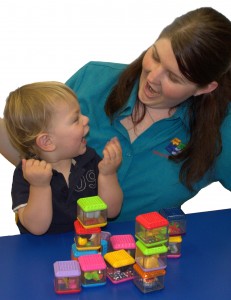
Concept words are important for children to use and to understand so that they can follow instructions accurately and pass information on clearly and specifically. They are also important for success later on in subjects such as maths and science.
Concepts include:
Position concepts
- 2 to 3 years: on, off, in, out, up, down, under, top, open, shut
- 3 to 4 years: bottom, behind, first, near
- 4 1/2 years: middle, around, away from, between, through, next to, beside, last
- 4 1/2 to 5 years: in front, in a line, corner
Size concepts
- 2 to 3 years: big, small/little, long
- 3 to 4 years: short (length and height)
- 4 ½ years: tall, fat
- 4 ½ to 5 years: thin
Quantity
- 2 to 3 years: one, two
- 3 to 4 years: three, every, none
- 4 ½ years: four, most, few
- 4 1/2 to 5 years: five, pair
Other concepts
- 2 to 3 years: stop, start, loud, quiet, heavy, soft, fast
- 3 to four years: hard, slow, light(weight)
- 4 to 5 years: same, different
Teaching Concepts:
Begin with an adult sorting objects or pictures while modelling and repeating the concept words. For example you might begin by putting big animals in a big box and small animals in a small box while saying “big bear, small dog”
Next the child sorts objects or pictures, while the adult models the concept word. For example the child might put the animals into big and little boxes while you say “big bear, small dog” etc
Next the child sorts and copies what you say.
Then the child sorts and says the concept word by himself. If he is not correct, model the correct word and ask him to copy you.
Finally the child practices the concept in games such as barrier games.
Learning to use concept words in real situations:
1. Model the words as they occur in your child’s real life experiences,for example, “you are getting in the bath, you are climbing over the fence, put on your blue shirt, find your big teddy”. etc.
2. Talk about these words as your child observes other people in kindergarten, on television and books. “Look, Sam has a red shirt, Jack is climbing over the log, Caitlin has the little pencil.”
3. Play games asking your child to place the objects in the position you ask, “put the car in the box, put the biscuit on the blue plate.”
4. When your child can do these activities with you in a game, see if they can follow instructions in everyday activities. For example “Put your drink bottle in your bag”. Begin with logical positions but try later illogical ones to encourage them to listen carefully, for example, “put your drink bottle under your bag”.
6. Playgrounds and kindergym are good places to model concept words as your child moves in, over, under and through the equipment. You could also make an indoor obstacle course with chairs, tables, boxes and blankets.
7. Books about concepts such as colours, shapes and numbers as well as flap books such as “spot books” are often good for talking about concept words.
8. Barrier games are also good for working on position words. With a screen between yourself and your child take it in turns to describe what you are creating on the other side of the screen, so the other person can copy, eg: building with blocks, setting up farm yard, placing pictures onto a scene etc. Each person must have the same items on each side of the screen. If the instructions were correct the creation on each side of the screen should be the same when the screen is removed. There is more information about barrier games in previous blog entries.
If you are concerned about your child's language or learning skills browse our website to see how speech pathology can help. Visit our downloads page for more information and printable activities.
Related posts:
4 1/2 year olds
3 1/2 year olds
What is language?
Top 10 language ideas
Related Blog Posts
If you liked this post you may also like:
Puppet Play 10 ways
Talk with me...about friends and feelings.
Developing recounts
Questions for school



